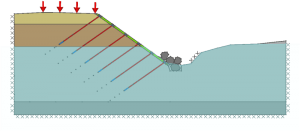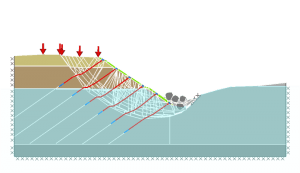How to Reduce the Risk of a Landslide
Posted on 15th October 2019
With some areas of the UK seeing two weeks’ worth of rain fall in just one hour earlier this week, the risk of landslides is playing on the minds of local authorities.
The issues with flash flooding and landslides are only set to get worse as more housing being built causes an increase surface water management. This water then being directed to certain confined areas. The rain water is unable to penetrate the ground where it has been developed and drain away naturally like it would have done previously. Global warming is also going to continue to contribute to these extreme downpours that we have been seeing over the past few years where we are subjected to weeks or months’ worth of rain falling in much smaller time periods.
What Causes a Landslide:
There are a few reasons as to why the ground may fail and cause a landslide, but one of the main causes is groundwater. Rising water tables and increased water pressures are contributory to most slope failures; the majority of landslides occur during or shortly after significant rainstorms. Slopes that are exposed to the elements which have not been reinforced are most at risk of failing.
Understanding the Mechanics Behind a Landslide:
When water penetrates the soil, it saturates the ground and reduces friction between the top layer of soils and harder layers of bedrock beneath. The top layer of soil then slides downwards creating the landslide.
Surface erosion happens as the displacement of soil from one area to another. On slopes, erosion is caused primarily by water, especially heavy rainfall. Rain that falls onto the exposed ground dislodges soil particles which are then carried away down the slope by the flowing water.
Slopes with no vegetation or cover are especially vulnerable to erosion issues. It is important to protect the slope surface from erosion during and after the project is complete.
How to Prevent a Landslide:
Slopes with no vegetation or cover are especially vulnerable to erosion issues. The most effective, natural way to control soil erosion on slopes is to plant vegetation. Not only will vegetation help to slow down raindrops as they fall, the roots of the plants will also help to hold the soil together, making it harder for water to wash it away.
Other than vegetation, a variety of engineered solutions are available to control erosion. Many of these solutions use biodegradable or geosynthetic mats that are designed to prevent erosion and give freshly planted vegetation a chance to grow. For steeper slopes, a cellular confinement system (e.g. Geoweb or Geocell – see Figures below) may be necessary. These engineered erosion control solutions may be used in conjunction with the Vulcan anchor system to provide a stable slope.
Vulcan Earth Anchors® can be driven into the areas which have been identified as being unstable or at risk of failing to stabilise it. These mechanical ground anchors can be inserted into any displaceable ground at right angles to the slope face. The Vulcan anchors are quick and simple to install and are able to hold loads of 250kN+
Geogrids or meshing can be used in conjunction with ground anchors to further control any surface erosion. These geotextile mesh grids allow vegetation to grow through them making them almost invisible and also further supporting the top soil when in place.
Preventative and Remedial Works:
Below you can see some of the work we have done to stablise slopes that were either at risk of failing or had already failed.













